P55 Overclocking Showdown - ASUS, Gigabyte, and EVGA at the OC Corral (Page 6 Updated)
by Rajinder Gill on November 6, 2009 12:00 PM EST- Posted in
- Motherboards
EVGA P55 FTW SLI
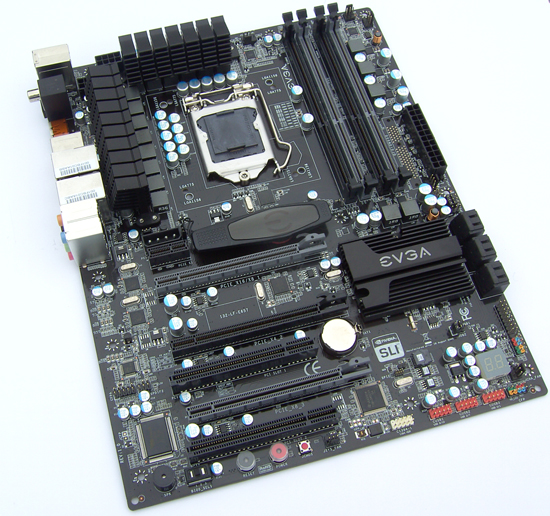
The EVGA E657 board is a little lighter in terms of onboard peripheral count when compared to the Gigabyte UD6 (additional SATA ports and software) and ASUS ROG, although the E657 FTW touts additional dedicated hardware features for overclocking (cold boot workarounds and 10 dedicated ICs allow for fine control of signal line compensation to the CPU, PCI/e and memory). CPU Power is supplied by a 12-phase, 600W capable PWM circuit, more than overkill on this platform.
A total of 7 fan headers are placed in accessible locations across the motherboard, with full fan speed control offered via BIOS. PWM cooling is catered for by two separate aluminium heat sinks that are attached to the board with screw fittings.
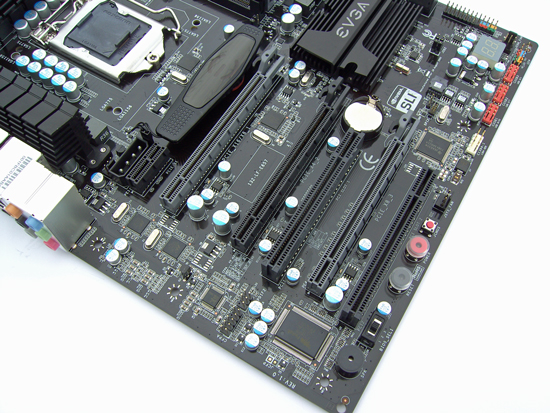
Starting at the top, expansion slot layout is comprised of PCI/eX1, PCI/e x16 (x8 if PEG slot 3 is occupied), PCI/e x4, PCI slot 1, PCI/e x8 and finally PCI slot 2.
Slot layout ensures that a PCI slot and the PCI/e x1 slots are always available/. The PCI/e x4 slot is also accessible when the primary PEG slot is occupied, although a double slot GPU will mean spacing will be tight. Underneath the last PCI slot, we find power, reset and CMOS clear buttons.
A three way slider switch is also provided allowing user selection of 3 separate BIOS IC’s. This allows flashing 3 different BIOS files, and also adds a good level of security in the instance of a corrupt BIOS flash. Along the bottom edge of the E657 we find a fan header, single IEEE-1394a connector, and three USB headers.
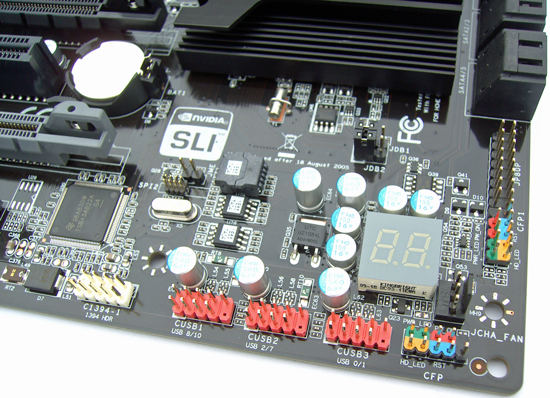
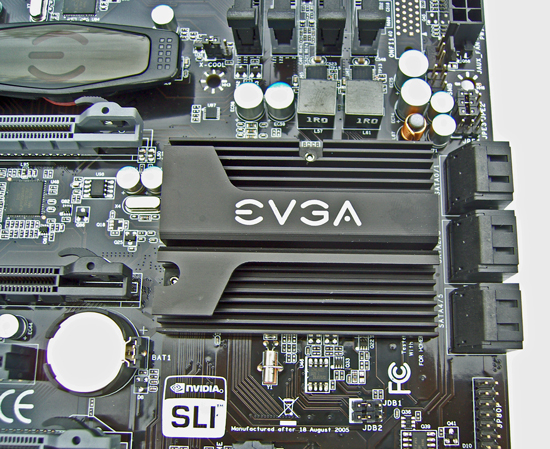
A hex post code display is placed in the lower right corner of the board and over to the left we find 3 BIOS IC’s, one of which is placed within a socket allowing removal if a swap out is required. The CFP1 connector is the EVGA OCP PCB panel connector which allows for on the fly changes 0.1V boost functions to CPU Core and VTT as well as a post code reader and power, reset and CMOS clear buttons.
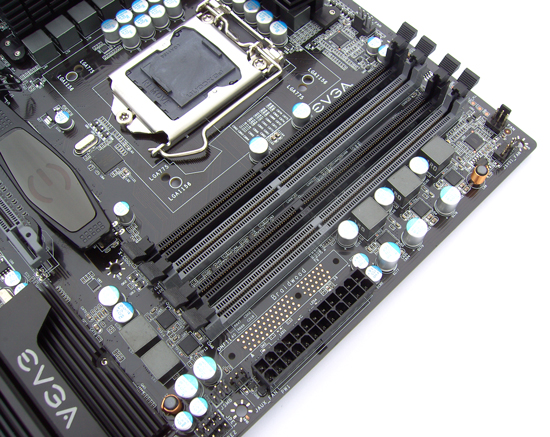
PCI/e disable and X-Cool jumpers are located underneath the DIMM slots. Memory power is supplied by a three phase controller supporting switching speeds up to 640KHz. Voltage measurement pads for all primary rails are located above the DIMM slots ensuring unhindered access in open test bed setups.

On the rear I/O panel we find, 1 x PS2, 7 X USB (1 SATA combo), 1x S/PDIF, 1x Optical, 1 x 1394, 2x RJ45 LAN and 6 x audio connectors. A CMOS reset button is located between the PS2 and S/SPDIF connectors for easy CMOS clear events with the board in a case.
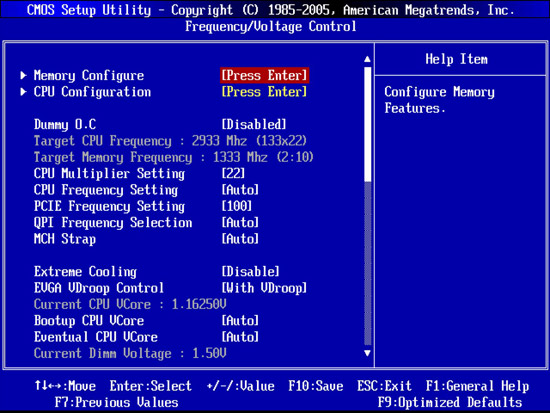
Worthy of mention here is the addition of boot up voltage settings for VTT and processor Core allowing users to cold boot processors at high frequencies by applying a lower voltage during initial post.

EVGA’s spin of a OS level overclocking tool know as E-LEET is also available for the P55 platform and is still the de-facto standard for all other OS overclocking tools to be judged against. ASUS’ new Connect software is close but simplicity rules here. The E-LEET GUI is remarkably compact and well laid out, offering voltage control, temperature/voltage readings, bus speed control, CPU-Z validation, quick load profiles and the ability to stop polling the SMbus. The latter feature is useful if you’d like to change processor speeds on-the-fly while minimizing the impact of having an application running in the background during a benchmark.
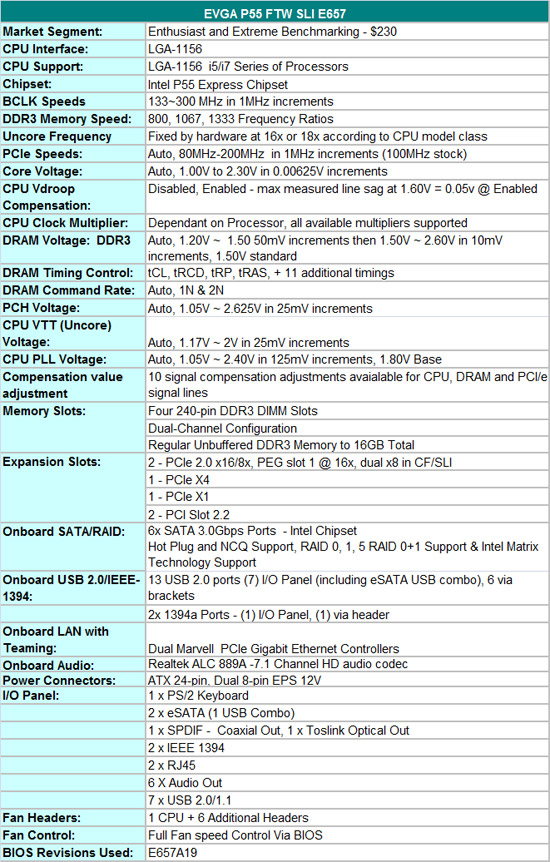
















52 Comments
View All Comments
McDaniel - Sunday, November 8, 2009 - link
Gigabyte is always ahead in cooling trend.. nice review anyway.. is it possible to set my old processor(core2duo) on this main board? & by the way where i should go for it?darkslyde - Monday, November 9, 2009 - link
you can't use socket 775 CPU in a socket 1156 board.but AFIAK, you can use socket 775 cpu cooling (heatsinks, cpu waterblocks) on the P55 evga boards. it has mounting for both 1156 & 775. that's one thing you can save on...
if you want to re-use your c2d (i.e e6600) there are good intel G/P/X 4X series and nvidia geforce 7000/9000, nforce 700 boards.
i'm reusing my old E6600 on an ASUS P5N7A-VM for media pc use. i get to use my old ddr2 dominators too.
techraze - Sunday, November 8, 2009 - link
Yes, you certainly can use it for core 2 Duo. but as this main board is designed for core i7/core i5 & their over clocking performances it's wise to have a new processor for this main board. i also did it recently & http://micropartsusa.com">http://micropartsusa.com can be a site for u also..anyway good luck dudeyyrkoon - Sunday, November 8, 2009 - link
As a matter of a fact. Doing some looking around I saw . . .LGA 1366 == i7 only
LGA 1156 == i5 only
LGA 775 == Core 2 duo, core 2 quad, core 2 extreme ( just another core 2 ), Pentium 4, and Celeron ( could be based on core2, P4, or others, but so long as LGA 775 pin layout).
Of course, with LGA 775, some manufacturers do not allow all CPU types, but it is possible for them to do, if they wish.
erple2 - Monday, November 9, 2009 - link
Technically,LGA 1366 == Certain i7 (9xx parts).
LGA 1156 == i5 and SOME i7 (8xx parts).
LGA 775 == Core2Duo, Core2Quad, and some Pentium 4 parts (any after "Northwood"), and some Celeron parts.
yyrkoon - Sunday, November 8, 2009 - link
Uh, you know I have not really looked into it, but I am fairly sure a socket 775 CPU would not fit into these newer sockets. Unless Intel took extreme precautions they normally have not in the past. I7 is what? 1368 pin ? Socket 775 is . . . 775 pin . . .MrCommunistGen - Saturday, November 7, 2009 - link
In the first paragraph of page 8 (the Gigabyte GA-P55-UD6 page)you mention cooling on the "ICH10R". It should probably say "PCH" instead.leexgx - Saturday, November 7, 2009 - link
even past reviews never seen these types of problems before guess P55 is an no go until they fix the socket issues (overclocking or not)yyrkoon - Saturday, November 7, 2009 - link
"Unfortunately, any jubilation for a platform winner ends here until we know the exact cause of the issues we experienced on motherboards using the Foxconn 1156 sockets."Does this mean that all boards use this socket ? Or does it mean that the ones you wish to be winners use this socket?
I also find it odd that you would mention the Gigabyte board is good, but costs too much, where surely it is fairly priced compared to many Asus boards of the past. Yeah, the same company who seemingly wins all of your top awards, and comparisons.
Asus is *not* that good. EVGA is definitely not that good. and Gigabyte while not perfect definitely is not as bad as you make it seem. Not only that, these three companies are definitely not the only three in the motherboard business. Why is it that MSI, DFI, and other board makers are no longer sending you samples for review ? Hmm . . .
Rajinder Gill - Saturday, November 7, 2009 - link
Gary has the MSI board already; it was not tested in this compare because of CPU damage. The too expensive comment is aimed at the EVGA Classified 200 which does not deliver a significant advantage over the other boards in terms of CPU/memory overclocking even for the extreme crowd. DFI's board was not ready as early as the 4 boards we have tested here.The socket comment was made because in light of the failures we experienced during testing. Our failures have been all related to Foxconn sockets, but there is now a confirmed user case having issues with a LOTES socket too. In light of this, it's hard to give any board accolades for raw overclocking until we know for sure that the 'problem' is fixed. Out of all the boards, the EVGA P55 FTW was the most consistent and easy to use. Also note, this article is in no way reflective of 24/7 PC's and what matters in typical usage scenarios.